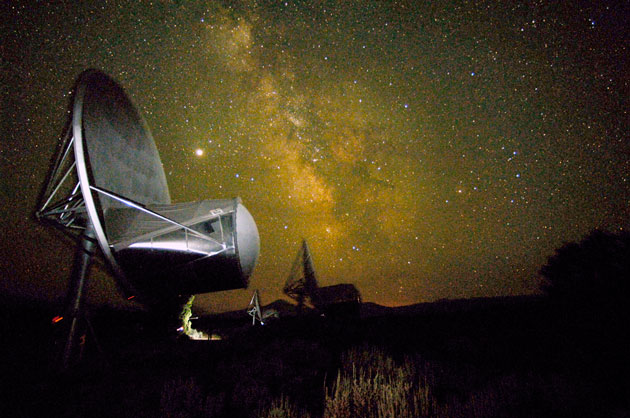
MOFFETT FIELD, Calif. — Astronomers have rebooted their search for intelligent life on alien planets, and they've got thousands of targets to scan.
After hibernating for more than seven months, a set of radio telescopes run by the SETI (Search for Extraterrestrial Intelligence) Institute has once again begun listening for signals from the many alien planet candidates discovered by NASA's Kepler space telescope, researchers announced Monday (Dec. 5).
"This morning, at 6:18, we began re-observing the Kepler worlds," Jill Tarter, director of the Center for SETI Research at the SETI Institute, said Monday during the Kepler Science Conference here at NASA's Ames Research Center. "We're just extremely excited to be back on the air today."
A long hibernation
SETI's Allen Telescope Array (ATA) is a set of 42 radio dishes located about 300 miles (500 kilometers) northeast of San Francisco. It began scanning the heavens for "technosignatures" — electromagnetic signals that could betray the presence of an intelligent alien civilization — in 2007. [10 Alien Encounters Debunked]
SETI researchers recently started using Kepler's discoveries to guide the ATA's activities. Kepler launched in March 2009 on a mission to hunt for Earth-size planets in their parent stars' habitable zone, that just-right range of distances where liquid water — and perhaps life as we know it — could exist.
In January of this year, Tarter said, the SETI team started training the Allen array on the 54 planet candidates Kepler had detected in the habitable zone to date.
Get the Space.com Newsletter
Breaking space news, the latest updates on rocket launches, skywatching events and more!
The work didn't last long, however. SETI had to shut the ATA down in April after budget problems forced the Institute's former partner, the University of California, Berkeley, to withdraw from the project.
SETI launched a crowdfunding site, www.setistars.org, in an attempt to get the array back up and running. And the public came through, donating enough money to take the ATA out of mothballs. As of Monday, citizens had chipped in more than $230,000.
Some funding help has also come from the United States Air Force, which is interested in using the array to track satellites and space debris, SETI officials said.
Many new worlds to scan
On Monday, the Kepler team announced the discovery of 1,094 new exoplanet candidates, bringing to 2,326 the total number of potential alien worlds the instrument has detected in its first 16 months of operation.
Researchers have confirmed only about 30 of these candidate planets to date, but Kepler scientists have estimated that at least 80 percent of them will end up being the real deal.
The ATA will take special interest in Kepler's candidates in the habitable zone, Tarter said. But SETI researchers hope to scan every last one of the potential planets to minimize the chances that we're blinded by our assumptions about where life "should" be.
"What we think we know actually might be a barrier to [finding] what is actually out there," Tarter said. "We intend to systematically explore all of these candidates."
The search of the Kepler candidates will involve scanning 9 billion different channels in a broad window of microwave frequencies. It should take two to three years, at $1.2 million per year, to search for signals from every potential alien world from the study, Tarter said.
It's exciting to focus the ATA on likely alien solar systems rather than just point the dishes toward stars and hope for the best, she added.
"We now know where to look for planets," Tarter said. "We're going to take the public's quest for technosignatures to the next level."
You can follow SPACE.com senior writer Mike Wall on Twitter: @michaeldwall. Follow SPACE.com for the latest in space science and exploration news on Twitter @Spacedotcomand on Facebook.
Join our Space Forums to keep talking space on the latest missions, night sky and more! And if you have a news tip, correction or comment, let us know at: community@space.com.

Michael Wall is a Senior Space Writer with Space.com and joined the team in 2010. He primarily covers exoplanets, spaceflight and military space, but has been known to dabble in the space art beat. His book about the search for alien life, "Out There," was published on Nov. 13, 2018. Before becoming a science writer, Michael worked as a herpetologist and wildlife biologist. He has a Ph.D. in evolutionary biology from the University of Sydney, Australia, a bachelor's degree from the University of Arizona, and a graduate certificate in science writing from the University of California, Santa Cruz. To find out what his latest project is, you can follow Michael on Twitter.









